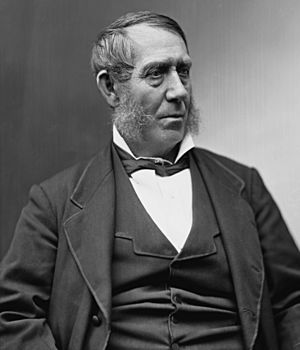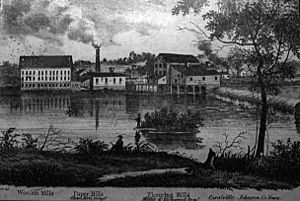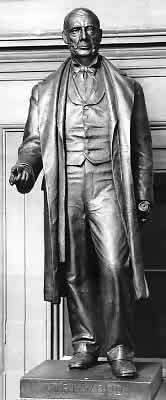Samuel J. Kirkwood facts for kids
Quick facts for kids
Samuel Kirkwood
|
|
|---|---|
 |
|
| 14th United States Secretary of the Interior | |
| In office March 8, 1881 – April 17, 1882 |
|
| President | James A. Garfield Chester A. Arthur |
| Preceded by | Carl Schurz |
| Succeeded by | Henry M. Teller |
| United States Senator from Iowa |
|
| In office March 4, 1877 – March 7, 1881 |
|
| Preceded by | George G. Wright |
| Succeeded by | James W. McDill |
| In office January 13, 1866 – March 3, 1867 |
|
| Preceded by | James Harlan |
| Succeeded by | James Harlan |
| 5th and 9th Governor of Iowa | |
| In office January 13, 1876 – February 1, 1877 |
|
| Lieutenant | Joshua G. Newbold |
| Preceded by | Cyrus C. Carpenter |
| Succeeded by | Joshua G. Newbold |
| In office January 11, 1860 – January 14, 1864 |
|
| Lieutenant | Nicholas J. Rusch John R. Needham |
| Preceded by | Ralph P. Lowe |
| Succeeded by | William M. Stone |
| Personal details | |
| Born |
Samuel Jordan Kirkwood
December 20, 1813 Harford County, Maryland, U.S. |
| Died | September 1, 1894 (aged 80) Iowa City, Iowa, U.S. |
| Resting place | Oakland Cemetery |
| Political party | Republican |
| Spouse | Jane Clark |
| Signature | |
Samuel Jordan Kirkwood (born December 20, 1813 – died September 1, 1894) was an important American politician. He served as the governor of Iowa two times. He was also a U.S. Senator for Iowa twice. Later, he became the U.S. Secretary of the Interior, a top job in the President's cabinet.
Contents
Early Life and Career

Samuel Jordan Kirkwood was born on December 20, 1813, in Harford County, Maryland. When he was 17, he started working as a teacher. One of his students was his cousin, Daniel Kirkwood, who later became a famous mathematician and astronomer.
Samuel spent some of his younger years in Washington, D.C. In 1835, he moved with his father to Ohio. There, he became known as a strong opponent of slavery. He joined the Republican Party, which was against slavery.
He was elected to several state jobs in Ohio. He worked closely with Thomas W. Bartley, who later became the governor of Ohio.
In 1855, Kirkwood moved to Iowa. He lived northwest of Iowa City. He started a business with the Clark family, who were also from Ohio. They worked together in a milling business. He also bought and sold land with the Clark and Lucas families.
Kirkwood married Jane Clark. She was the sister of Phoebe Ann Clark. This made him the brother-in-law of Edward Lucas. Edward was the son of Iowa's first Territorial Governor, Robert Lucas.
Samuel Kirkwood had planned to stop being involved in politics when he moved to Iowa. However, he became interested in the new Republican Party. In February 1856, he was called from his mill in Coralville to speak at the founding meeting of the Iowa Republican Party. He arrived still covered in flour dust.
His speech was very powerful and helped the Republican Party become successful in Iowa. That same year, he was elected to the Iowa Senate. He served there from 1856 to 1859.
Governorship and the Civil War
Becoming Governor of Iowa
In 1859, Kirkwood was chosen to run for governor. He won against Augustus C. Dodge after a difficult campaign. The main topic of the campaign was slavery.
In 1860, his first year as governor, the John Brown raid on Harpers Ferry made the country even more divided over slavery. Kirkwood strongly supported those who wanted to end slavery.
When Barclay Coppock, a young man from Springdale, Iowa, who was part of Brown's raid, escaped to Iowa, Kirkwood refused to send him back to Virginia. He allowed Coppock to get away.
Iowa's Role in the Civil War
During the American Civil War, Kirkwood became well-known across the country. He worked very hard to get soldiers and supplies from Iowa for the Union Army. He strongly supported President Abraham Lincoln's plans during the war.
He was very active in raising and preparing many regiments of infantry (foot soldiers). He also helped get cavalry (soldiers on horseback) and artillery (large guns) ready for the Union Army.
In 1862, Kirkwood went to the Loyal War Governors' Conference in Altoona, Pennsylvania. At this meeting, governors from Union states showed their support for President Lincoln. This support helped Lincoln issue the Emancipation Proclamation, which declared many enslaved people free.
Life After Governorship and National Roles
After his first time as governor ended in 1864, Kirkwood moved to a new house in Iowa City. This house is now on Kirkwood Avenue. He started working as a lawyer. Around this time, he sold his part of the mill business.
Serving as a U.S. Senator
From 1865 to 1867, he served the rest of James Harlan’s term in the U.S. Senate. He then became governor of Iowa again from 1876 to 1877. He resigned as governor in 1877 to start his second term as a U.S. Senator. He served in the Senate again from 1877 to 1881.
Secretary of the Interior
In 1881, Kirkwood left his Senate job. He became the Secretary of the Interior under President James A. Garfield. He held this important position until 1882. Later, in 1886, he tried to run for Congress but did not win.
Samuel Kirkwood passed away on September 1, 1894, in Iowa City, Iowa. He is buried in Oakland Cemetery.
Memorials and Honors
Many places and things are named after Samuel J. Kirkwood to remember his important work.
Statues and Plaques

- A sculpture of Kirkwood was made by artist Vinnie Ream. It is one of two statues from Iowa displayed in the National Statuary Hall Collection in the United States Capitol in Washington, D.C.
- A bust (a sculpture of his head and shoulders) of Kirkwood is in the Vicksburg National Military Park.
- There is a special memorial plaque in front of Iowa City High School.
Schools Named for Kirkwood
- Kirkwood Community College is named after him. This college has several campuses in eastern Iowa.
- Kirkwood Elementary School is located in Coralville, Iowa. This is the town where Kirkwood used to run his mill.
Places Named for Kirkwood
- The town of Kirkwood, Illinois is named in his honor.
- Kirkwood Avenue in Iowa City, Iowa.
- Kirkwood Avenue in Des Moines, Iowa.
- Kirkwood Boulevard in Davenport, Iowa.
- The Kirkwood House in Iowa City is a historic building. It is listed on the National Register of Historic Places.
- The Hotel Kirkwood in Des Moines is also named after him and is on the National Register.



